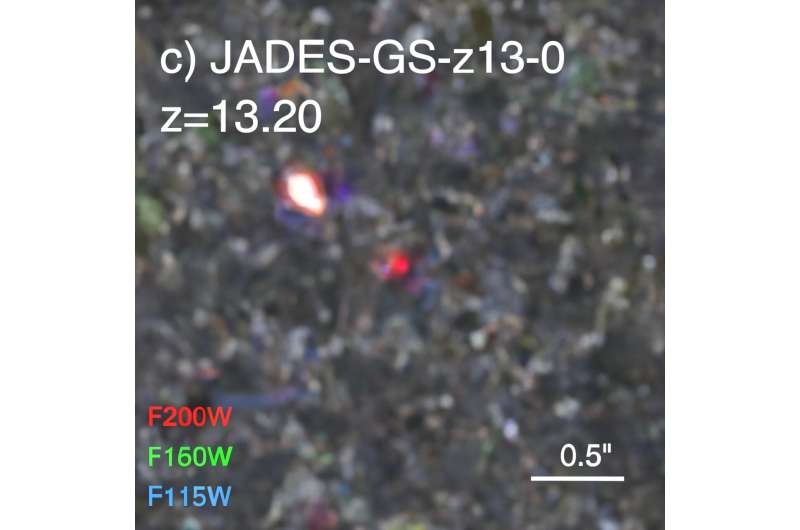This article has been reviewed according to Science X's editorial process and policies. Editors have highlighted the following attributes while ensuring the content's credibility:
fact-checked
preprint
trusted source
proofread
Quenched galaxies in the early universe

Recently, much attention has been given to massive, active galaxies discovered by the JWST in the early universe. But in contrast to these active galaxies, some galaxies that the JWST has discovered have been unusually quiet with little to no active star formation.
This is surprising because the early universe had a greater density of galaxies, leading to more interactions, and thus, more star formation. So finding galaxies in which star formation has been shut down so early has astronomers puzzling over the question how to kill a galaxy?
This question isn't new. Even the relatively nearby cosmos has galaxies which have had their star formation quenched, often in short order. Previous research has shown that the distribution of active star formation in galaxies is not smooth. Rather, galaxies seem to be either active or dead, with fewer galaxies in between. This suggests that there is a mechanism which shuts down star formation rapidly as opposed to a slow death of a galaxy due to passively running out of materials.
Astronomers investigating the mechanisms behind this have considered two main suspects: active galactic nuclei (AGN) and supernovae. In both cases, these energetic events would heat the interstellar medium making the conditions within potential star forming regions too warm to condense. Indeed, the density required for a nebula to collapse (known as the Jeans density), is particularly sensitive to the temperature.
But a new study posted to the arXiv preprint server examines whether supernovae can be a culprit for galaxies going quiet in the early universe. This research differs from previous studies because the star formation rate is dependent on several factors, including chemical composition which has evolved over time, adding more heavy elements to the universe. Thus, previous studies explaining quenching in the nearby universe may not apply to early galaxies.
To test whether supernovae were responsible, the authors built a model to explore how much energy supernovae could pumping into their local galaxies. This was then compared to the observed properties of two quenched galaxies (JADES-GS-z13-0 and MACS0417-z5BBG) discovered by the JWST to determine whether supernovae would be heating the interstellar medium faster than the energy could be dissipated through other mechanisms.
The research indicated that supernovae would be more efficient at halting star formatting in smaller galaxies. However, while both galaxies were considered low-mass, the two galaxies explored were both sufficiently massive that supernovae heating would be outpaced by cooling mechanisms. Thus, supernovae are not likely to be the culprit in the case of these galaxies.
At the same time, both galaxies did not display signs of an active galactic nucleus, also casting doubt on this mechanism. Thus, the authors consider whether there might be another mechanism at play.
Previous studies of the galaxies have indicated that, while the galaxies are quiet now, they both had undergone a period of starburst in which the star formation rate was significantly higher. The authors suggest that, even without the addition of supernovae, the radiation pressure from the burst of star formation (and especially the hot, young stars created during it) would itself be enough to heat the gas. Thus, they suggest, the "particularly bursty" nature of early galaxies may itself stunt the star formation rate.
However, this suggestion was already explored in another recent study also posted to arXiv. That study created simulations of galaxies using three different models. In each of them, they were able to produce simulations which would result in a halt to star formation. However, the models also indicated that the effect was only temporary. Additionally, the authors studied the same two quenched galaxies and concluded that, at least for JADES-GS-z13-0, the timing of the bursty era did not match the expectations of the model.
Ultimately, the topic will need to be explored further as more early, quenched galaxies are discovered. This will allow further examples to compare against the various quenching models to find where their limits are and give better boundaries on where the various mechanisms may dominate.
More information: Viola Gelli et al, Can supernovae quench star formation in high-z galaxies?, arXiv (2023). DOI: 10.48550/arxiv.2310.03065
Tibor Dome et al, Mini-Quenching of High-Redshift Galaxies by Bursty Star Formation, arXiv (2023). DOI: 10.48550/arxiv.2305.07066
Journal information: arXiv
Provided by Universe Today




















